A rent increase notice is a legal letter that is sent by the landlord of a rented property to their tenant in order to inform the tenant of a change in the amount that is required to be paid to rent the property.
The rent increase notice form is often sent by certified mail in order to establish a paper trail and make sure that the tenant received the notice. Giving the letter to the tenant by hand or informing them by speech will cause problems in the future because this act will not be considered a proper form of communication and can be easily denied in court. The rent increase notice form will be usually handed out before the end of the lease to give time to the tenant in case they decide to refuse the change in rent.
A rent increase notice is also known as the following;
- Notice to Increase Rent
- Rent Change Notice
- Letter to Increase Rent.
Rent Increase Notice Templates
Following are some free rent increase notice templates to help you with a rent increase notice;
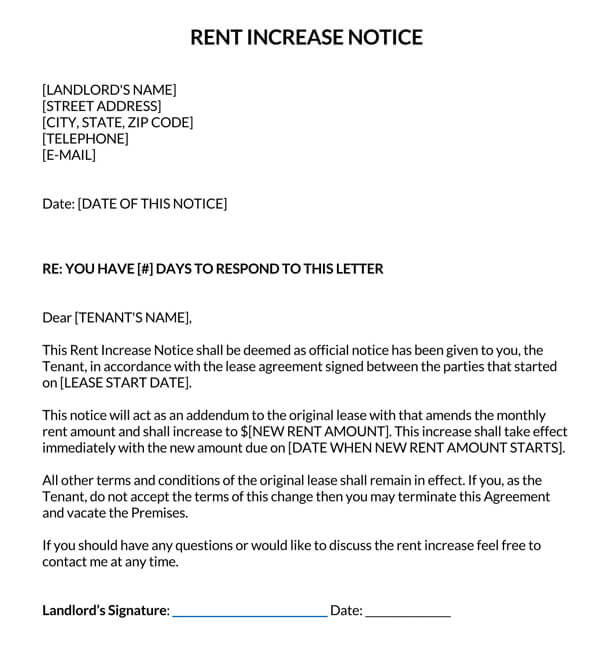
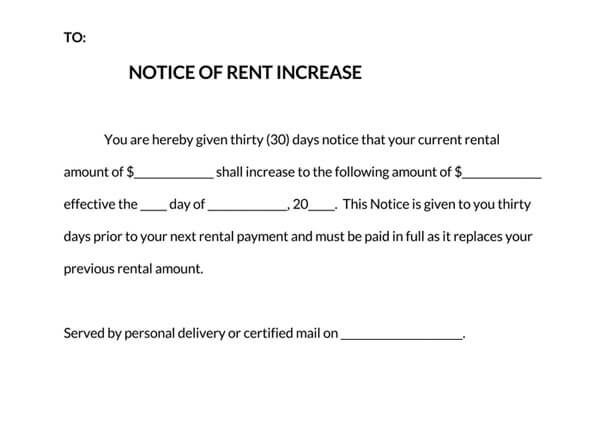
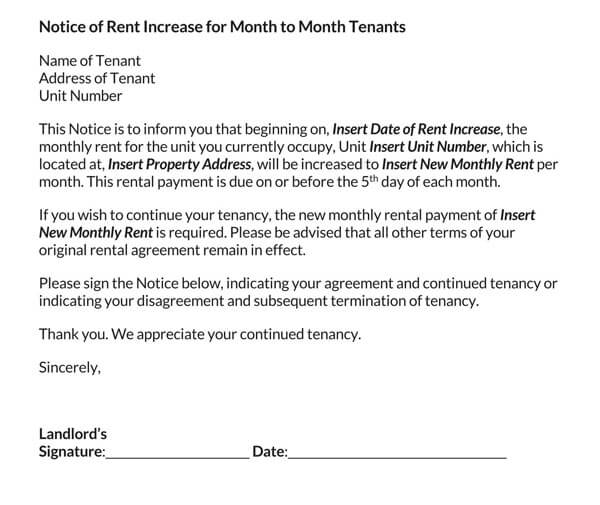
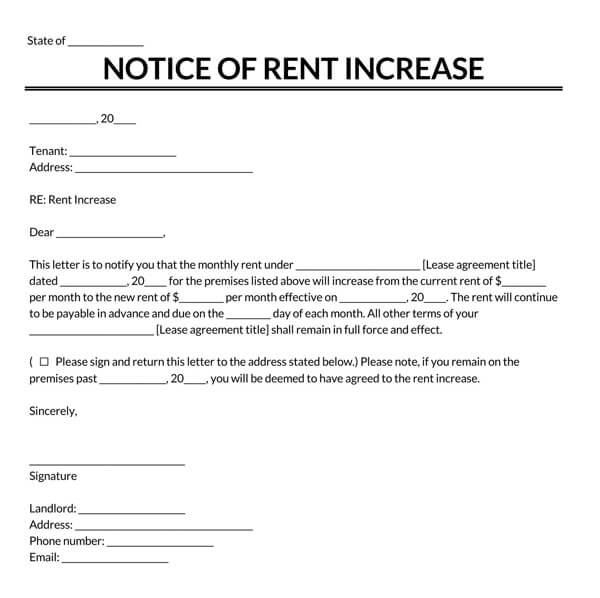
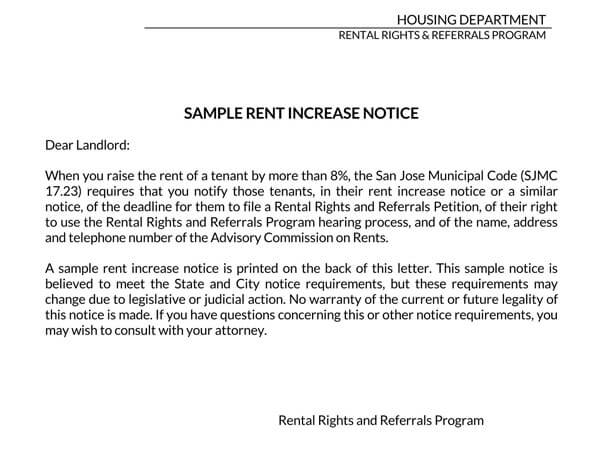
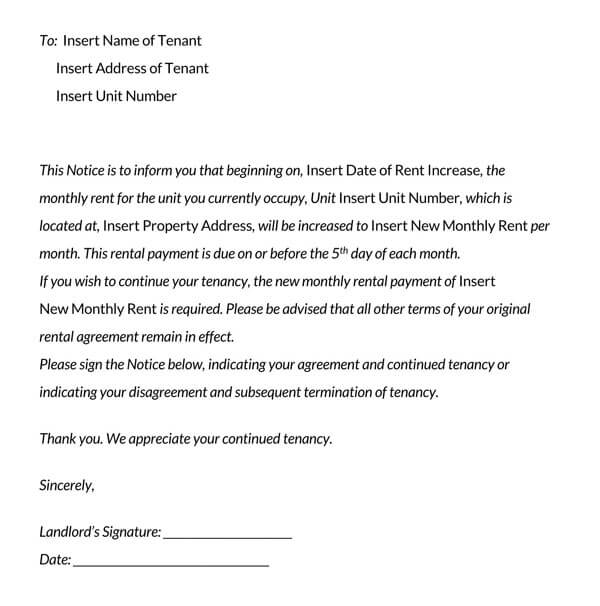
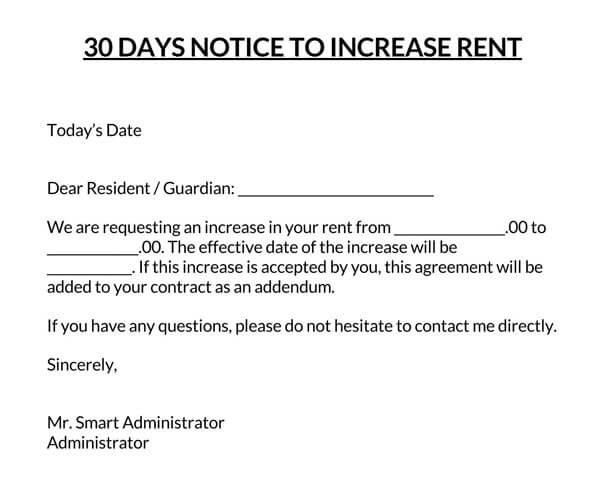
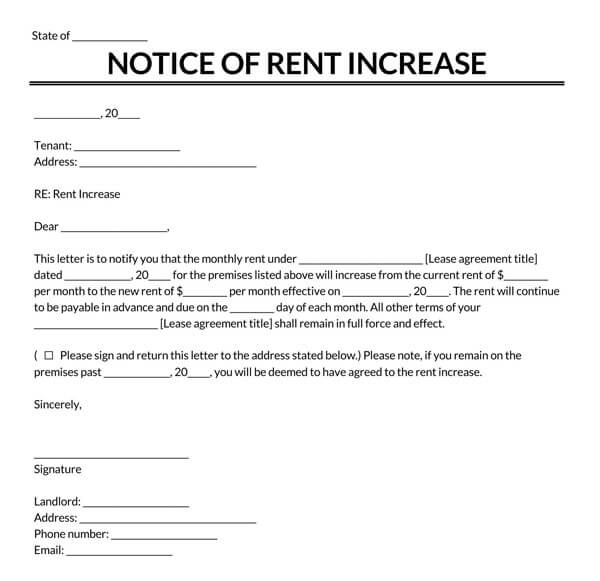
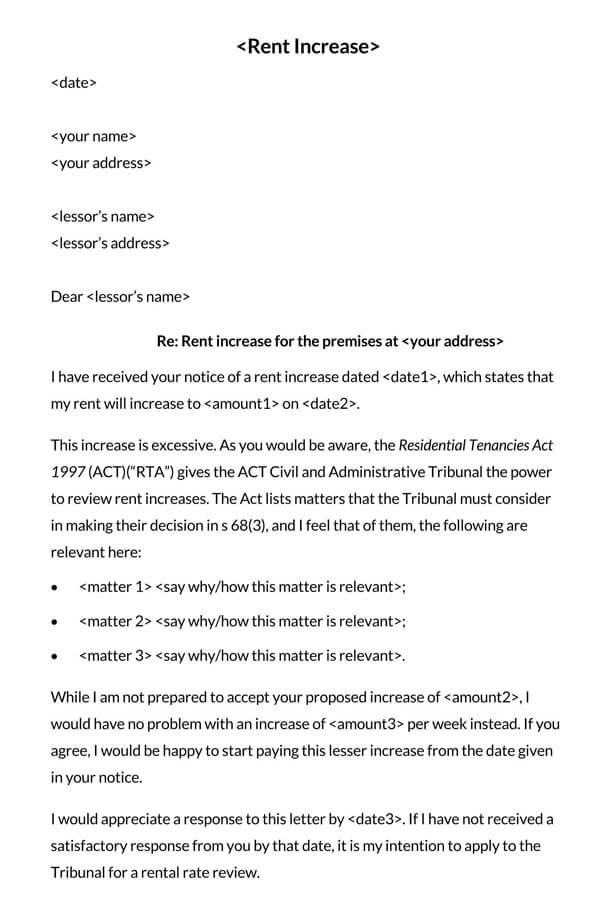
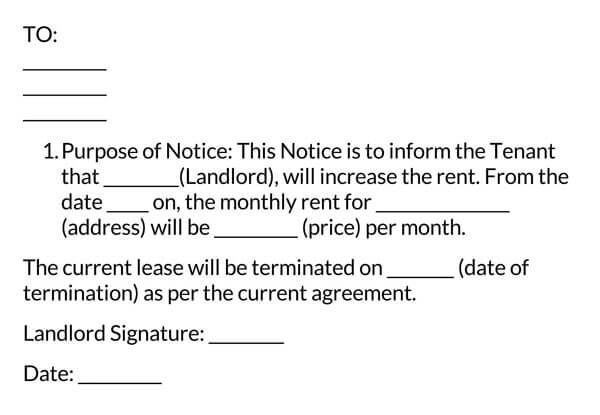
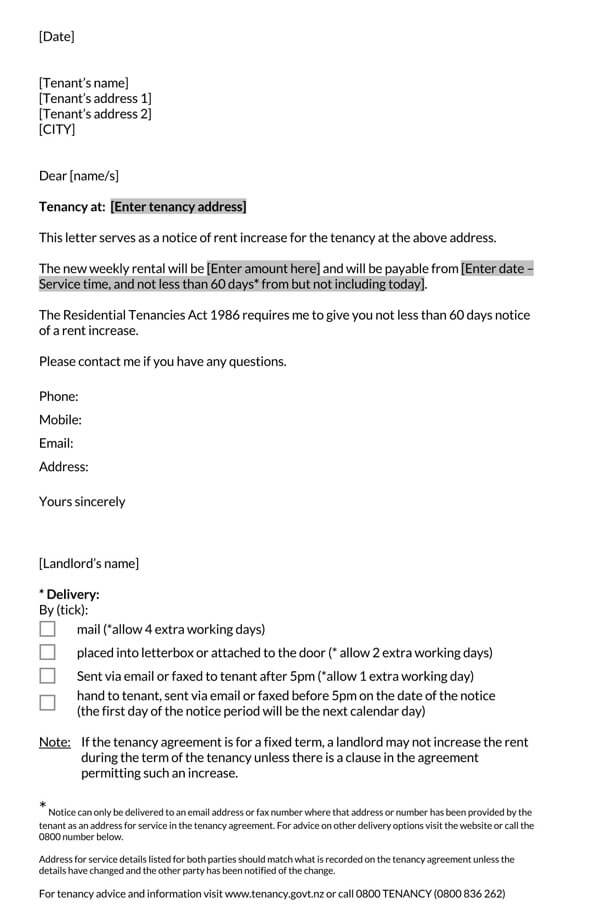
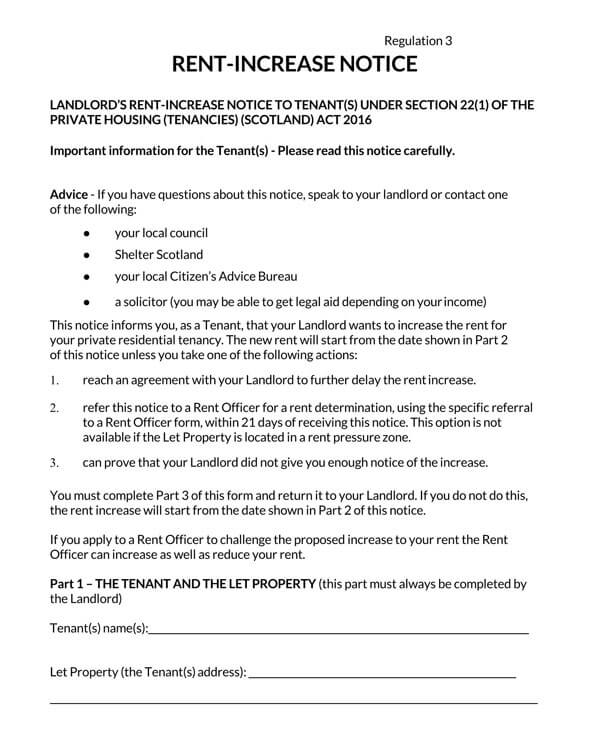
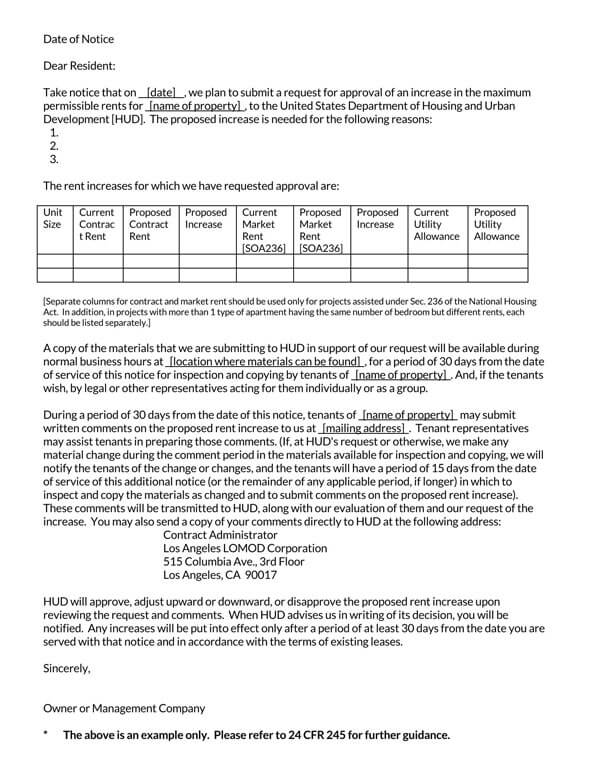
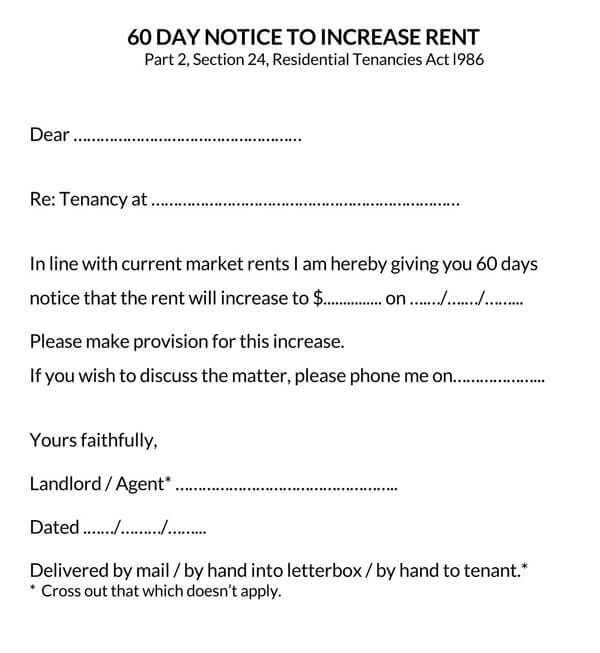
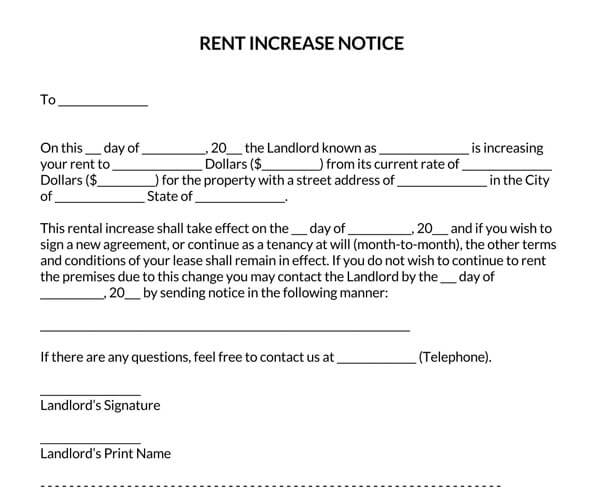
Common Reasons for Increasing Rent
An increase in the rent of a property is sometimes necessary due to factors that the landlord cannot control. Basically, increasing the rent of a property helps with its maintenance costs which result in the property owner being able to bring the property’s price up to date with the current market.
Some of the causes for an increase in the rent are:
Legal causes
An increase in the rent as a direct cause of legislation by governmental entities, economical reasons, and other causes, including:
- Property tax increase: Any structural change in the property that will increase the perceived value of the property will incur an increase in the property tax.
- Increase in insurance premiums: An increase in the amount to pay for insurance that will cover any damage to the property.
- Increase in Homeowner Association (HOA) Fees or condo fees: an HOA can increase its fees to meet an annual budget which will increase the expenses on the property.
- Annual inflation (The World Bank Publishes Inflation Rates in the U.S): an increase in the general prices of goods and services can warrant an increase in the rent of a property.
- Property upgrades: upgrading the property will be beneficial to the tenants and improve the quality of life, which can be a good reason for the landlord to increase the rent.
Social causes
An increase that is based on social causes is such that the rent of the property depends on the local market and the conditions relating to the living situation in that area.
For example:
- Increase in cost of living: as the cost of living increases, the landlord will need to spend more on basic expenses such as food and water. Increasing the income of the landlord will help in this case.
- Increased demand: When the demand for the property increases, the value of the property in the market will increase. The landlord can increase the rent to match the market.
- Unforeseen expenses: unexpected expenses to the property such as repairing damages and maintaining the look of the property.
Forewarnings for the Landowners
The rent of a property cannot be increased for arbitrary reasons. The landlord needs to provide adequate reasons for the increase in rent. The terms of the increase in rent are regulated by the local government, thus it is important to revise the local regulations before deciding to increase the rent prices of a property.
Some of the rules and conditions that the landlord need to comply with are:
Rent increase during the lease term
An increase in the rent cannot occur while The Lease Term is active. The agreement within the lease requires a certain amount of payment from the tenant and an increase in this amount is not allowed until after the lease expires. The tenant can still remain in the property if they decide to sign an extension to the lease under new terms.
Adequate written notice
An adequate amount of time must be given to the tenant in case of a month-to-month rental without a lease. The amount of time the tenant should have differs depending on the regulatory authority in the state. This given time can range from 28 days to 60 days or more. The time can also be dependent on the percentage of increase of the rent.
For example:
In California, if the rent is increased by 10% of the original rent or more, a notice of 60 days is mandatory.
Amount of increase
The amount of increased rent should be justified and in accordance with the local market. An exaggeration of the increase in the rent will often result in the increase being rejected. Having good reasons for the increase in price can warrant a higher increase in the rent, such as Covering expenses regarding insurance premiums or taxes. It should also be taken into consideration that the increase in rent might also incur an increase in the security deposit according to the Lease Agreement. The security deposit can be a percentage of a month’s rent or more.
Act of retaliation
An increase in the rent is often rejected by the tenant if the tenant perceived the increase as a form of retaliation and aggression towards the tenant. The regulatory authority in the state often has rules and conditions to prevent such cases such as considering any increase in rent within 60 to 180 days after the tenant has filed a complaint or reported a housing code violation will be considered as an act of retaliation.
Right to reject rent increase
The tenant has the right to reject the increase in the rent. The landlord cannot force the tenant to accept the increase. The landlord can evict the tenant once their lease is over, as the tenant will no longer have the claim over the property and will be held responsible for the increased rent.
Unfair discrimination
Unfair discrimination against the tenants according to the tenant’s beliefs, ethnicity, gender, disabilities, and other reasons will be unacceptable. The tenant can refuse the increase and will be able to fight it in court. This is according to the Fair Housing Act. The tenant can file a complaint to the Housing and Urban Development (HUD) against the landlord for discriminatory actions. The HUD will launch an investigation in regard to these complaints and will decide if any legal action is necessary. There are states with more protected classes against discrimination, such as age, sexual orientation, student status, and family status.
Sending a Rent Increase Notice
After deciding the new rent and checking the laws that govern such changes in the rent. A rent increase notice needs to be delivered to the tenant in order to inform the tenant of this change.
There are multiple ways of delivering the notice to the tenant, they are: giving the notice to the tenant in person, sending it through certified mail, by Email, or by courier service. The preferred way is through certified mail as this will provide confirmation that the tenant has received the notice by providing a receipt of delivery that the landlord can keep.
In Alabama, a sheriff will serve the notice to the tenant on behalf of the landlord.
The rent increase notice should be given to the tenant between 15 to 60 45 days depending on the terms of the Lease and the jurisdictions of the state where the property is located.
How to Format a Rent Increase Notice
Preparing a rent increase notice is not a complicated matter and can be perfected if a few factors are kept in consideration.
Following are the steps to write a rent increase notice efficiently:
Type of lease
State the type of lease that will bind the tenant to the property, whether it is month-to-month or year-to-year. It is important to state the type of the lease as it will affect the number of days given before the change of the rent.
Location of the property
The address of the landlord (return address) should be written down as well as the formal mailing address as listed on the lease that the particular rent increase notice will concern.
Date of writing
The date on which the letter is written should be mentioned by the landlord upon writing the notice in the form of DD/MM/YYYY. Provide the number of days given to the tenant in order to respond to the letter. The date of writing is useful as a reference point for the future to ensure enough time was given to the tenant.
Names of both the parties
The full names and titles of both the involved parties should be written mentioned clearly.
Current rental amount
The amount of rent (In Dollars) before the increase should be stated.
Lease effective date
The date on which the current lease that the rent increase notice is concerned with was signed is the lease effective date and this must also be mentioned. This is done in order to apply the notice to this lease. The lease needs to allow a change in the rent amount before it expires.
The amount of increase
Write down the amount that is making an increase to the rent in dollars. There can be a limit to how much can be increased within the lease or according to the state laws that the property is located in.
Payment method and due date
The payment method preferred by the landlord can be in person, by mail, or any other method. The due date of the increased amount of rent is also stated.
Time needed for non-renewal notification
The amount of time given to the tenant to reject the increase in the rent and inform the landlord that the tenant would not be renewing the lease must be specified in this step.
Signature and date of effect
The landlord signs the document and writes the date on which the increase will take effect.
Reference to pertinent section of the lease
Reference the part of the lease agreement that concerns the amount of rent and terms of changing the amount of rent.
Frequently Asked Questions
How much can the landlord raise the rent?
There is usually no maximum to the amount that the landlord can raise the rent, however, this is usually regulated by governmental authorities and according to the state where the property is located.
What are the legislative changes affecting the rent increase?
From the 12th of August 2020, increasing the rent is only allowed once per 12 months. Previously, the rent was only allowed to change once every 180 days.
Any Rent Increase notices signed after the 12th of August 2020 will need to be in compliance with the 12-month rule. However, any notices given before that date will be applying to the 180 days rule.
Does a rent increase affect the security deposit?
The security deposit is usually dependent on the rent amount, for example, the security deposit amount is three times the monthly rent. The increase in the amount of rent will result in an increase in the security deposit accordingly. The landlord can request that the increase in security deposit is paid once the increase in the rent has taken effect. There are cases where a landlord will have a fixed security deposit that won’t change with the increase in the rent or the landlord can choose to not request the increase in security deposit from the already leased tenants.
What are the drawbacks of not using a Rent Increase Notice?
The drawbacks of not using the Rent Increase Notice are plenty. The landlord will miss out on opportunities to increase the amount of rent that can be asked on a monthly basis. The landlord will also need to pay the expenses of a lawyer in case a tenant filed a complaint against the landlord in cases of retaliation or discrimination. The landlord can also engage in stressful situations in cases of verbal agreements to raise rent without the use of a Rent Increase Notice
When should I reduce the rent and when should I keep it the same?
The rent of the property should be decreased in order to match the local market. Asking for a higher-than-market rent will make your property less appealing and increase your vacancy. The rent should also be decreased in cases of market saturation. When there is an increase in the available rentable properties without an increase in the number of tenants. Decreasing the rent is beneficial in making the property more appealing even if the decreased rent is only short-term.
Keeping the rent without change is essential in maintaining the tenants in cases of financial uncertainty. Having tenants that pay on time and abides by the rules is more valuable than a vacant slot that is wasting time without bringing income.